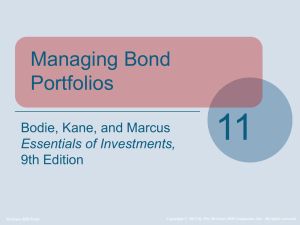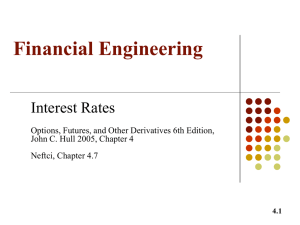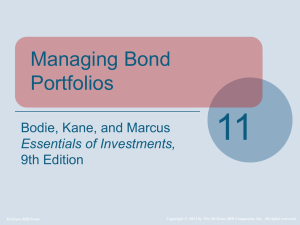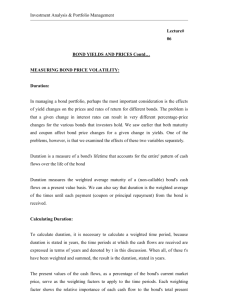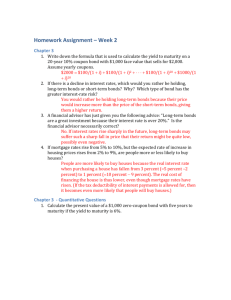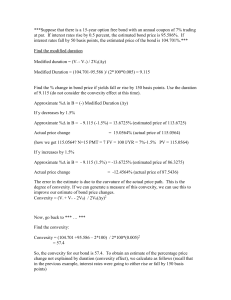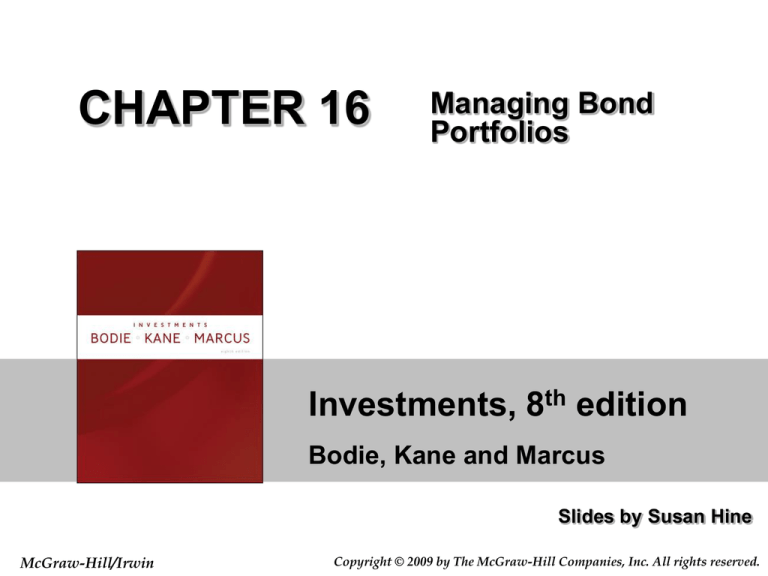
CHAPTER 16
Managing Bond
Portfolios
Investments, 8th edition
Bodie, Kane and Marcus
Slides by Susan Hine
McGraw-Hill/Irwin
Copyright © 2009 by The McGraw-Hill Companies, Inc. All rights reserved.
Bond Pricing Relationships
• Inverse relationship between price and yield
• An increase in a bond’s yield to maturity
results in a smaller price decline than the
gain associated with a decrease in yield
• Long-term bonds tend to be more price
sensitive than short-term bonds
16-2
Figure 16.1 Change in Bond Price as a
Function of Change in Yield to Maturity
16-3
Bond Pricing Relationships Continued
• As maturity increases, price sensitivity
increases at a decreasing rate
• Price sensitivity is inversely related to a
bond’s coupon rate
• Price sensitivity is inversely related to the
yield to maturity at which the bond is selling
16-4
Table 16.1 Prices of 8% Coupon Bond
(Coupons Paid Semiannually)
16-5
Table 16.2 Prices of Zero-Coupon Bond
(Semiannually Compounding)
16-6
Duration
• A measure of the effective maturity of a
bond
• The weighted average of the times until
each payment is received, with the
weights proportional to the present value
of the payment
• Duration is shorter than maturity for all
bonds except zero coupon bonds
• Duration is equal to maturity for zero
coupon bonds
16-7
Duration: Calculation
wt CF t (1 y )
t
Price
T
D t wt
t 1
CFt Cash Flow for period t
16-8
Spreadsheet 16.1 Calculating the
Duration of Two Bonds
16-9
Duration/Price Relationship
Price change is proportional to duration and not
to maturity
(1 y )
P
Dx
P
1
y
D* = modified duration
P
D * y
P
16-10
Rules for Duration
Rule 1 The duration of a zero-coupon bond
equals its time to maturity
Rule 2 Holding maturity constant, a bond’s
duration is higher when the coupon rate is
lower
Rule 3 Holding the coupon rate constant, a
bond’s duration generally increases with its
time to maturity
Rule 4 Holding other factors constant, the
duration of a coupon bond is higher when the
bond’s yield to maturity is lower
Rules 5 The duration of a level perpetuity is
equal to: (1+y) / y
16-11
Figure 16.2 Bond Duration versus
Bond Maturity
16-12
Table 16.3 Bond Durations (Yield to
Maturity = 8% APR; Semiannual
Coupons)
16-13
Convexity
• The relationship between bond prices and
yields is not linear
• Duration rule is a good approximation for only
small changes in bond yields
16-14
Figure 16.3 Bond Price Convexity: 30Year Maturity, 8% Coupon; Initial Yield to
Maturity = 8%
16-15
Correction for Convexity
1
Convexity
P (1 y ) 2
CFt
2
(1 y )t (t t )
t 1
n
Correction for Convexity:
P
D y 1 [Convexity (y ) 2 ]
2
P
16-16
Figure 16.4 Convexity of Two Bonds
16-17
Callable Bonds
• As rates fall, there is a ceiling on possible
prices
– The bond cannot be worth more than its
call price
• Negative convexity
• Use effective duration:
P / P
Effective Duration =
r
16-18
Figure 16.5 Price –Yield Curve for a
Callable Bond
16-19
Mortgage-Backed Securities
• Among the most successful examples of
financial engineering
• Subject to negative convexity
• Often sell for more than their principal
balance
– Homeowners do not refinance their loans
as soon as interest rates drop
16-20
Figure 16.6 Price -Yield Curve for a
Mortgage-Backed Security
16-21
Mortgage-Backed Securities Continued
• They have given rise to many derivatives
including the CMO (collateralized mortgage
obligation)
– Use of tranches
16-22
Figure 16.7 Panel A: Cash Flows to Whole
Mortgage Pool; Panels B–D Cash Flows to
Three Tranches
16-23
Passive Management
• Bond-Index Funds
• Immunization of interest rate risk:
– Net worth immunization
Duration of assets = Duration of liabilities
– Target date immunization
Holding Period matches Duration
16-24
Figure 16.8 Stratification of Bonds into
Cells
16-25
Table 16.4 Terminal value of a Bond Portfolio
After 5 Years (All Proceeds Reinvested)
16-26
Figure 16.9 Growth of Invested Funds
16-27
Figure 16.10 Immunization
16-28
Table 16.5 Market Value Balance Sheet
16-29
Cash Flow Matching and Dedication
• Automatically immunize the portfolio from
interest rate movement
– Cash flow and obligation exactly offset each
other
• i.e. Zero-coupon bond
• Not widely used because of constraints
associated with bond choices
• Sometimes it simply is not possible to do
16-30
Active Management: Swapping
Strategies
•
•
•
•
•
Substitution swap
Intermarket swap
Rate anticipation swap
Pure yield pickup
Tax swap
16-31
Horizon Analysis
• Select a particular holding period and predict
the yield curve at end of period
• Given a bond’s time to maturity at the end of
the holding period
– Its yield can be read from the predicted
yield curve and the end-of-period price can
be calculated
16-32
Contingent Immunization
• A combination of active and passive
management
• The strategy involves active management
with a floor rate of return
• As long as the rate earned exceeds the floor,
the portfolio is actively managed
• Once the floor rate or trigger rate is reached,
the portfolio is immunized
16-33
Figure 16.11 Contingent Immunization
16-34





